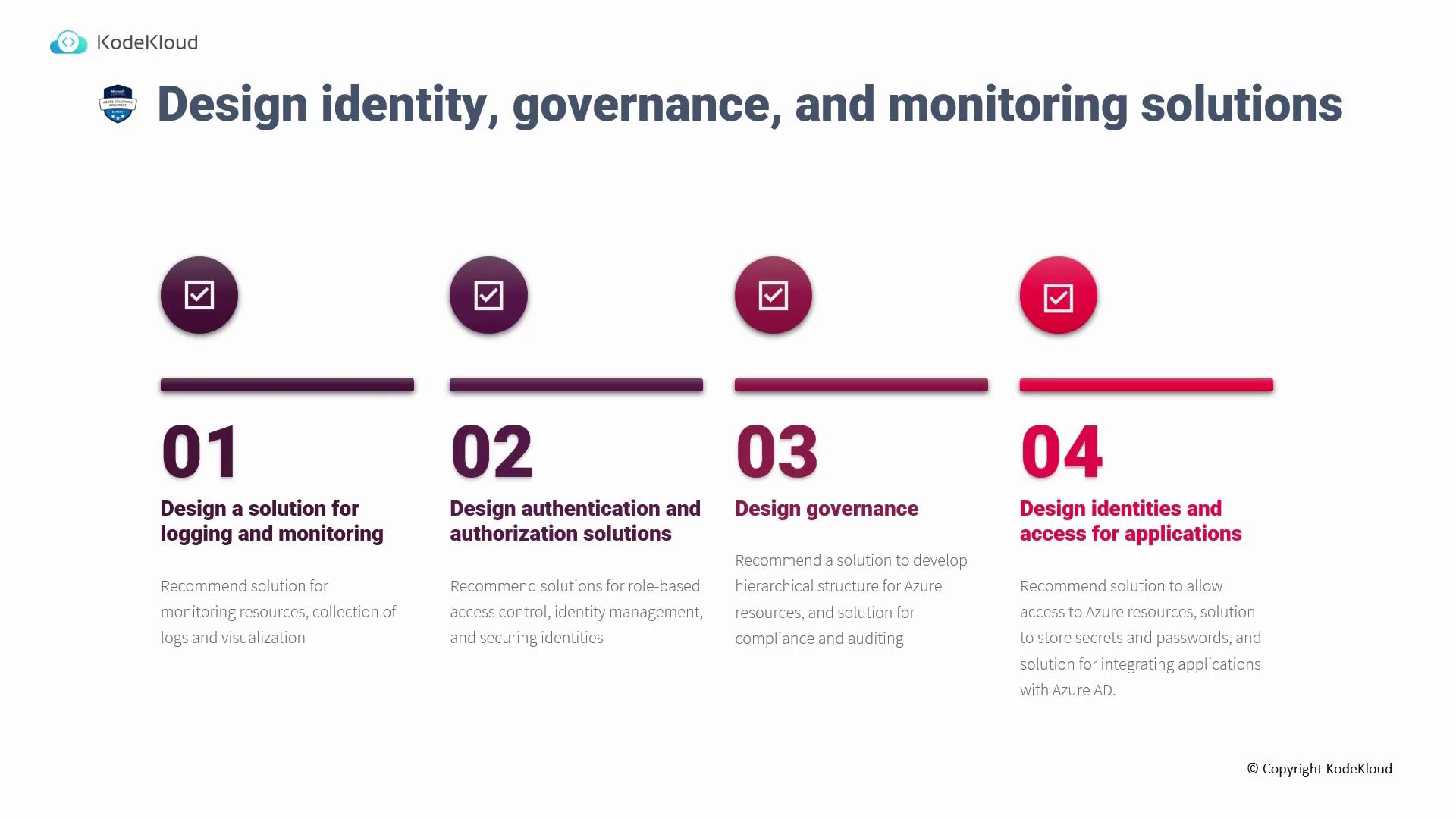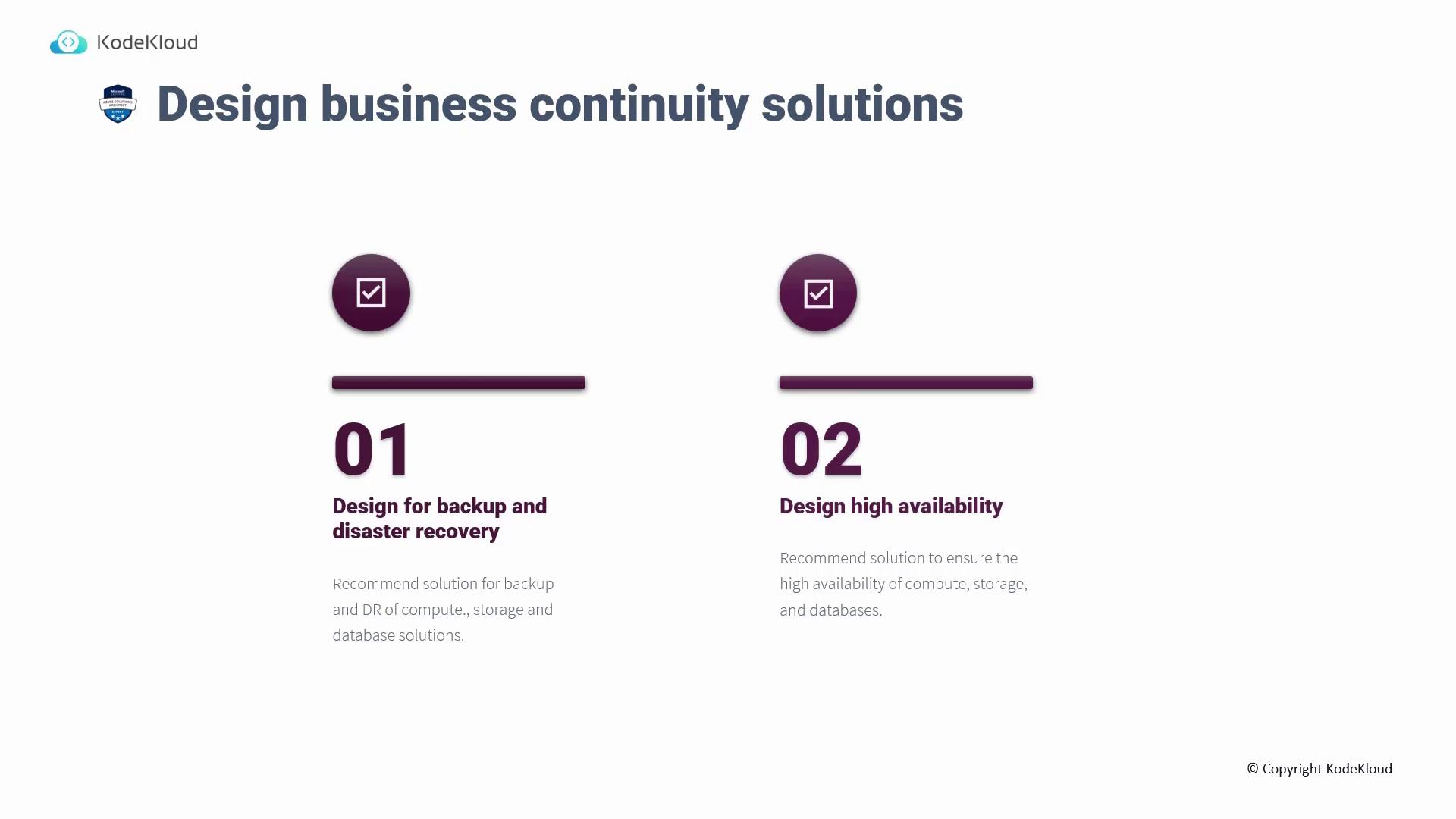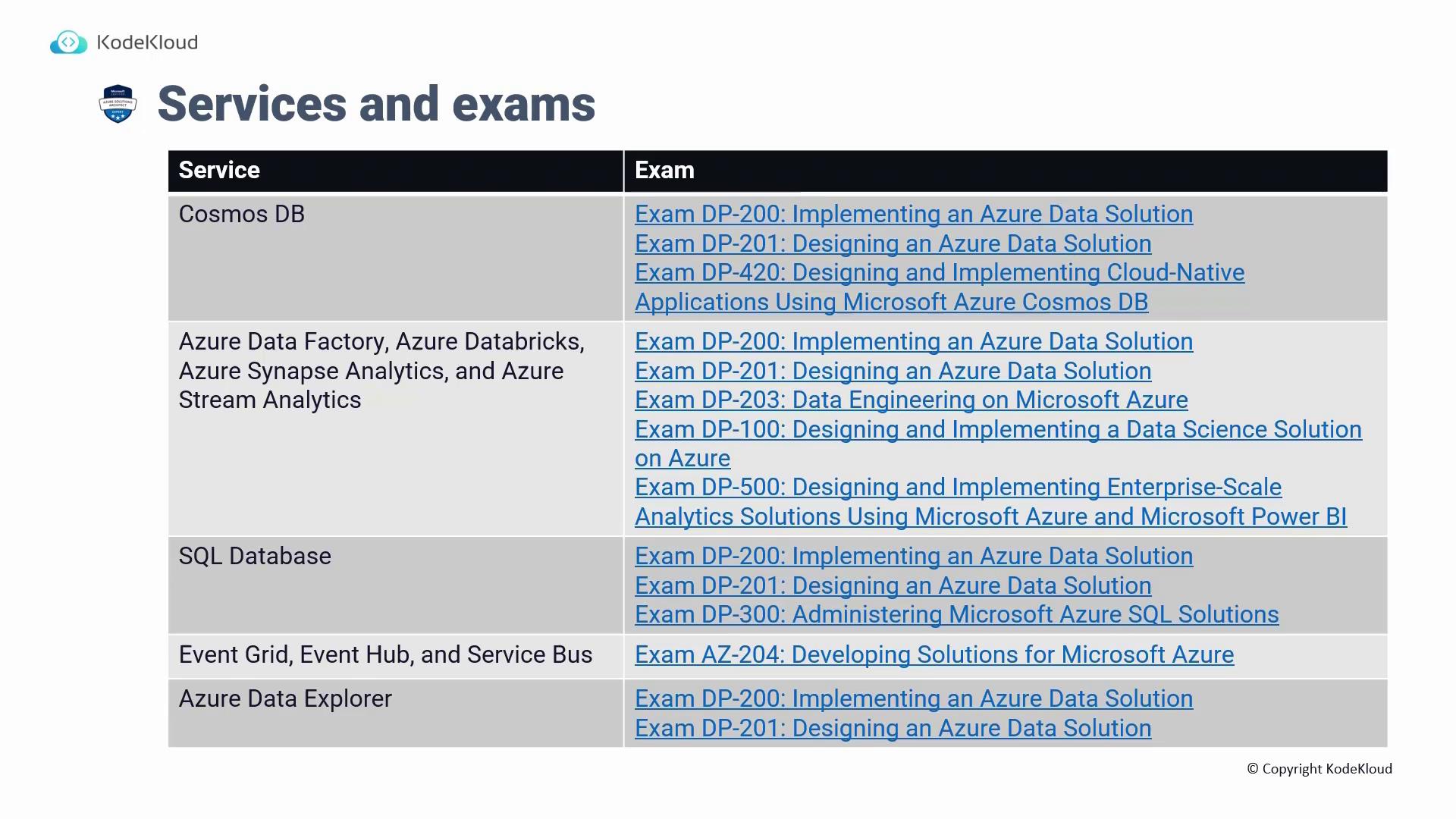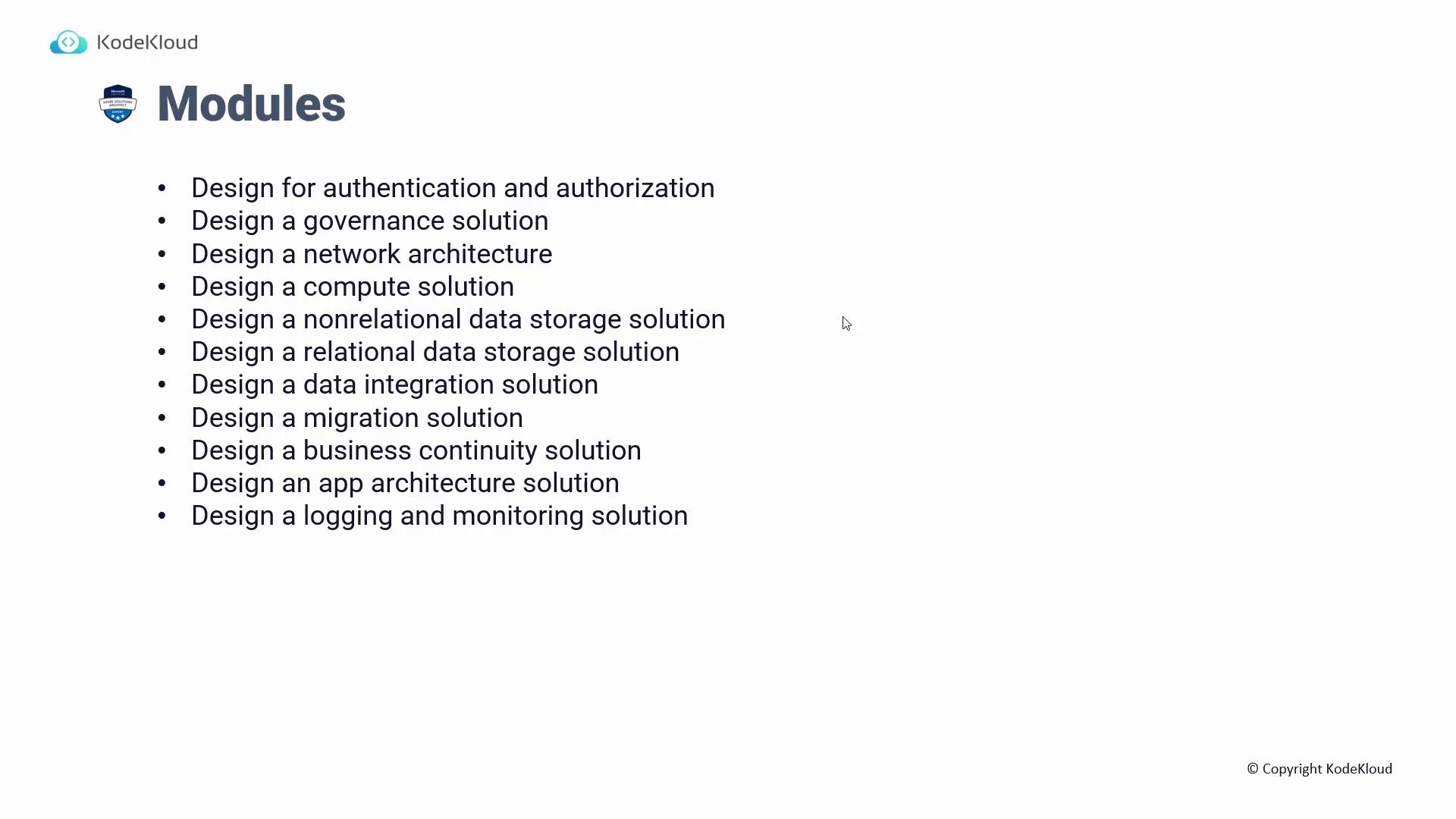AZ-305: Microsoft Azure Solutions Architect Expert
Introduction
Certification Details
In this lesson, we explore the certification roadmap for becoming a Microsoft Azure Solutions Architect. This comprehensive guide outlines your progression from fundamental concepts to advanced design principles, offering a clear pathway to planning your certification journey.
Azure Fundamentals
Begin your Azure journey with the AZ-900: Azure Fundamentals course. Although optional, this course is highly recommended for those new to cloud concepts. It provides the essential foundation you need before advancing to more specialized courses like Administrator or Architect.

Azure Administrator and Solutions Architect
After completing or bypassing the Fundamentals, enroll in the AZ-104: Azure Administrator course. This course acts as a prerequisite for the AZ-305 certification, which is designed for future Azure Solutions Architects. If you have already gained experience with AZ-104, you're well-prepared to take on the Solutions Architect challenge.
Passing the AZ-305 exam will earn you the prestigious Azure Solutions Architect Expert badge.
Skills Measured in AZ-305
The AZ-305 exam assesses your ability to design Azure solutions across several critical domains. The main skills measured include:
- Design Identity, Governance, and Monitoring Solutions (25-30%)
- Design Data Storage Solutions (25-30%)
- Design Business Continuity Solutions (10-15%)
- Design Infrastructure Solutions (25-30%)
These exam areas cover the essential topics and ensure that you are well-prepared for real-world challenges.

Detailed Module Breakdown
Design Identity, Governance, and Monitoring Solutions
In this module, you will learn to design and recommend solutions for:
- Logging and Monitoring: Architect systems for resource monitoring, log collection, and data visualization.
- Authentication and Authorization: Develop strategies to implement role-based access control and secure cloud identities.
- Governance: Establish a hierarchical structure for managing Azure resources, ensuring compliance and effective auditing.
- Application Access Management: Integrate solutions for managing secrets, passwords, and application access with Azure Active Directory.

Note
In this lesson, modules 2 and 4 are combined to maintain continuity. The focus is on designing and recommending solutions rather than on the hands-on implementation approach used in the Azure Administrator course.
Design Data Solutions
This module covers essential aspects of data management and storage design:
- Relational Data: Explore design considerations for structured data.
- Data Integration: Learn methods for integrating diverse data sources within Azure.
- Unstructured Data Storage: Examine best practices for storing and managing unstructured data.
- Nonrelational Data: Investigate design options suitable for nonrelational databases.
Design Business Continuity Solutions
This module is subdivided into two focused areas:
- Backup and Disaster Recovery: Develop strategies to ensure the continuity of compute, storage, and database services in disaster scenarios.
- High Availability: Design solutions to guarantee high availability across compute, storage, and database systems.

Note
High availability concepts are integrated into the respective sections (compute, storage, and database) to provide a comprehensive contextual discussion.
Design Infrastructure Solutions
In this section, focus on designing robust infrastructure solutions that include:
- Compute: Use Microsoft’s flowchart to choose optimal compute options based on your specific requirements.
- Application Architecture: Design effective communication strategies between application components using messages and events.
- Migration: Recommend the best migration strategies for servers, databases, and web applications.
- Network Solutions: Design secure and efficient virtual network communications along with hybrid connectivity options.

Frequently Asked Questions
What level of experience is required?
Microsoft recommends that candidates have advanced IT operations experience in areas such as networking, virtualization, identity, security, business continuity, disaster recovery, data platforms, and governance. Familiarity with networking terminologies like CIDR and FQDN is also important.
Does this lesson cover the implementation of all services?
No, this lesson focuses solely on the design aspects of Azure solutions. Each Azure service has its own specialized exam for implementation. For detailed implementation topics, such as Azure Active Directory, consider pursuing the AZ-500 certification.
Why are there more case studies than quizzes?
Microsoft emphasizes the importance of case studies and architectural reviews to help you adopt an architect’s perspective when selecting Azure solutions. The focus is on recommending services based on best practices rather than on their direct implementation.
Can beginners take this course?
Yes, beginners are welcome to take this course. However, you might need to invest additional time in learning fundamental IT concepts such as networking, virtualization, security, business continuity, disaster recovery, and data governance through supplementary documentation.
Services and Exams Overview
This course also provides an overview of how various Azure services align with specific certification exams. For example, consider the following table:
| Azure Service | Certification Exam |
|---|---|
| Azure Virtual Machines | AZ-104: Azure Administrator |
| Azure App Service | AZ-104: Azure Administrator; for development, see AZ-204: Developing Solutions for Microsoft Azure |
| Azure Batch and Kubernetes | AZ-104: Azure Administrator and AZ-204: Developing Solutions for Microsoft Azure |
| Functions and Logic Apps | AZ-204: Developing Solutions for Microsoft Azure |
| Azure Storage | Covered in AZ-104 with additional focus in AZ-204 |
For data architects, additional exams such as DP-200, DP-201, DP-203, and DP-300 are available. For security-focused roles, the AZ-500 certification is recommended.


For more information, you can browse additional certifications by role on the official Microsoft portal.
Course Modules Order
The modules in this lesson have been thoughtfully reordered to ensure a seamless learning experience. The sequence is as follows:
- Authentication and Authorization
- Governance
- Network Architecture
- Compute Solutions
- Nonrelational Data
- Relational Data
- Data Integration
- Migration Solutions
- Business Continuity
- Application Architecture
- Monitoring

Now, let’s begin with authentication and authorization. Good luck on your journey to becoming an Azure Solutions Architect!
Watch Video
Watch video content